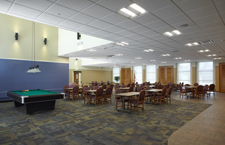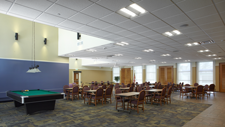Energy-saving systems light the way in Minnesota public housing

RTLED lighting fixtures with SensorSwitch occupancy controls from Atlanta-based Lithonia Lighting have reduced energy consumption at the Minneapolis Public Housing Authority (MPHA), which is the largest public housing authority in Minnesota.
The lighting upgrade took place at an MPHA high-rise senior apartment complex. Renovations within the 25-story building included hallways, stairwells and community rooms that were illuminated 24 hours a day, 365 days a year, despite being unoccupied most of the time.
The MPHA overcame building code challenges in its efforts to upgrade its facility lighting. “The Minneapolis building code did not allow occupancy sensors in emergency egress areas, and stairwell lighting needed to be seven times brighter to meet the new building codes,” said John Plifka, MPHA manager of facilities and development.
The final solution included the fixtures paired with SensorSwitch occupancy controls that allowed lighting in the common areas — including egress lighting — to be turned off unless someone was in the area. Redundancy was built into the design to allow MPHA to meet life safety codes. Both the lighting and controls are served by several existing emergency circuits for each of the areas.
“We petitioned the city for a building code variance,” said Plifka. “The city of Minneapolis conducted an in-depth review and approved the new lighting system.” Upon approval from the city, the MPHA installed 125 RTLED luminaires and 375 RT5DLED downlights throughout all public spaces of the high-rise. This included common areas like hallways, stairwells, offices, kitchens, boiler room and more.
“Even though the new code required seven times more light, the RTLED fixture paired with occupancy sensors allowed us to significantly reduce our energy use,” said Plifka. “Specifically, our stairwell lighting system is used only when needed, which currently adds up to about three hours a day. The LED lighting and the occupancy sensors together helped us reduce our energy use by 90 percent in the stairwells, and the LED fixtures are expected to last 45 years.”
Cost savings extend beyond the stairwell lighting, explained Plifka. “Throughout the entire building, the RTLED lighting system and the controls reduced energy consumption by more than 77 percent, reduced carbon dioxide emissions by 76 percent and reduced maintenance costs by 58 percent,” said Plifka.
MPHA plans to continue installing LED lighting in its facilities as appropriate based on final measured data points. “The RTLED lighting system is working perfectly and the feedback from residents and property management staff has all been positive,” said Plifka.




















